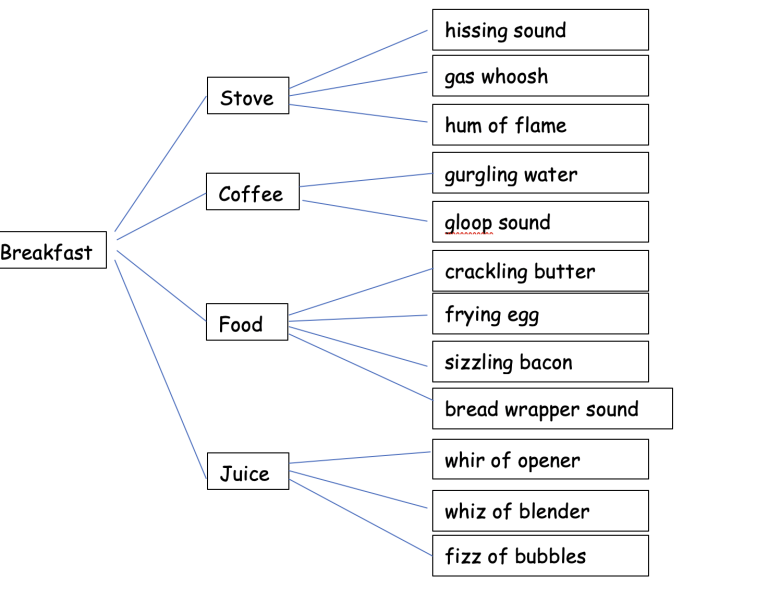Chapter 5.1 Description
Description
 Filmmakers make their movie worlds come alive through images, motion, sound, and special effects. Writers need to think like filmmakers and make their story worlds come alive through description.
Filmmakers make their movie worlds come alive through images, motion, sound, and special effects. Writers need to think like filmmakers and make their story worlds come alive through description.
Prewriting for Descriptive Writing
Choosing a Topic
When writing a descriptive essay, choose a subject that leads itself to description. You should be able to describe images or objects using some of the five senses. To get in the frame of mind, try thinking about the sounds, sights, tastes, smells, and feelings you should experience in certain places, such as a busy restaurant, a hospital, a subway car, a zoo, and so on.
If you are choosing your own topic,
- Select something with which you are familiar
- Review your journal for ideas
- Talk to friends or post on Facebook to determine what readers may want to know about
- Look through old photos of trips you have taken, at art, movies, or other points of interest.
To help gather and organize support for your topic,
- Determine what you want your description to do: create an impression or persuade a reader to act
- Identify the interest of your readers – perhaps talk to others
- Brainstorm additional details
- Link sensory impressions to details with key words
- Connect details with the dominant impression you want to make
- Map the order of your description.
After brainstorming a list of potential details, you might use branching to start accumulating sensory impressions. Below is an example of using branching to obtain and group the sensory impressions for a paragraph describing the sounds of the kitchen at breakfast time.
Elements of Descriptive Writing
Sensory Details
Rich description allows readers to imaginatively experience the subject by providing details that describe what something looks like and even how it sounds, smells, feels, and tastes. These sensory details give readers a rich experience, much like a movie
|
Sense |
Example(s). |
|
Sight |
The sea of golden wheat swayed, almost danced in the breeze. The majestic Glacier Park lodge sat proudly at the end of the long-manicured lawn. I gazed at the endless night sky afire with glittering stars. |
|
Sound |
The heavy door creaked open revealing a dim interior. In the distance, the fireworks sizzled and boomed, announcing another year. The ominous beat of helicopter blades cutting through the air put us all on edge. |
|
Taste |
She sipped the bitter coffee wishing for cream. As the boy bit into the crisp Granny Smith apple, his face puckered at the unexpected tartness. A metallic tang filled my mouth as blood began to pool under my tongue. |
|
Touch |
I shivered uncontrollably even though I was zipped in my down sleeping bag. With every step, my pack rubbed my hips and shoulders raw, leaving sores screaming for me to stop. Tessa’s soft fur felt like silk against my skin. |
|
Smell |
As we walked into the bakery, my senses were assaulted with sweet confections–buttery caramel, rich chocolate, yeasty dough, and burnt sugar. I felt of tickle of dust at the back of my throat as I walked down the aisles of musty books. |
Abstract Descriptions Versus Concrete Descriptions
Try to avoid vague, abstract descriptions. For example, a writer may write beautiful to describe a tree. However, beautiful is too vague. Instead, a concrete adjective or modifier would be stronger and gives greater impact. The reader needs details for a picture to form in their heads, abstract concepts like beautiful lack a real-world analog. Here’s a reworked description of the tree: “the sun’s rays glistened off the rain-slick leaves, even as the afternoon sky dipped towards evening.” The beautiful qualities of the tree are “shown” through concrete details instead of merely told through abstraction. This gives the reader the illusion of immediate experience, as opposed to the dictionary variety.
Abstract Descriptions
Abstractions are often ideas that cannot be seen, heard, touched, or smelled.
Examples of abstract descriptions:
- the sad man
- the happy woman
- the beautiful dog
- a lovely house
- an amazing sight
Concrete Descriptions
A concrete description can be seen, heard, touched, or smelled.
Examples of concrete details:
- the crunching sound
- the melted candy cane
- the burnt toast
- the flashing light
- the smooth butter
There are appropriate times to use abstractions. For instance, if the reader is already aware of the circumstances (i.e., a writer is referring to a passage from a novel, in which the audience knows of a certain event) then the writer can generalize the emotion. However, especially in creative works such as fiction and poetry, it is best to turn the abstract into the concrete.
Similes and Metaphors
By adding similes and metaphors to a description paper, the writer can appeal to the readers’ imagination and make the writing more interesting to read. Similes and metaphors add spark to descriptions.
Spatial Order
Spatial order, described in Chapter 4, means explaining or describing objects as they are arranged in space. Spatial order is less common in college writing and best used for the following purposes:
- helping readers visualize something as you want them to see it
- evoking a scene using the senses (sight, touch, taste, smell, sound)
For example, an essay that describes a microscope or the parts of a guitar would use spatial order. You create a picture for the reader. The view must move in an orderly, logical progression, giving the reader clear directional signals (“to the left is…,” “above that…,” “on the back is…”).
Writing a Descriptive Paragraph
Description paragraphs typically describe a person, a place, or an object using sensory details. The topic sentence should convey the writer’s overall impression of the person, place, or object described in the body paragraphs. The organization of the paragraph may best follow spatial order, an arrangement of ideas according to physical characteristics or appearance. Depending on what the writer describes, the organization could move from top to bottom, left to right, near to far, warm to cold, frightening to inviting, and so on. For example, if the subject were a client’s kitchen in the midst of renovation, you might start at one side of the room and move slowly across to the other end, describing appliances, cabinetry, and so on. Or you might choose to start with older remnants of the kitchen and progress to the new installations. Maybe start with the floor and move up toward the ceiling.
Examples
Last Tuesday morning was my most relaxing time of the week. After taking classes and working from Wednesday through the following Monday, it was nice to be able to sleep in without using my alarm clock. When I opened my eyes, it was already after 10 am. The apartment was quiet as my neighbors were working. The sun was gently shining on my bed through the translucent curtain. I lazily stretched myself in bed till I was fully awake. In my pajamas and slippers, I spent the next half an hour tidying up my bedroom and living room. At 11 am, with soft music playing, I started preparing my brunch. Since I had been studying and working hard all week, I decided to treat myself: a glass of freshly squeezed orange juice, half a cup of mixed nuts, and a plate of home-made omelet filled with vegetables, cheese, and some shreds of leftover roasted chicken breast. I took time to eat and savor each bite. Life was good! When my leisurely brunched ended, I had recovered from the week’s fatigue. I was ready for new challenges in the afternoon.
Writing a Descriptive Essay
The first step in any descriptive writing is to choose a topic and begin to work out a thesis statement. As was suggested in the previous sections, you may choose to describe a particular place.
Thesis
Example
We can see in this thesis statement that the writer will attempt to show the aspects of Minnesota that make it a great place to live. After detailing a thesis statement, you should come up with a list of sensory words that provide vivid detail and support the thesis. You may start by thinking about the five senses. How does your particular place look, smell, feel, taste, and sound like? How can you best describe these senses so the reader feels what you feel? By organizing the elements of descriptive language into easier to handle sections, like the five senses, you are able to more specifically engage in what elements of the description are most useful.
The writer in this case could choose to present the positive aspects of Minnesota in terms of the seasons and weather changes. The details could be presented linearly, starting with spring and going through the winter, highlighting the aspects of each season that most closely support the thesis, that Minnesota is a great place to live.
Prior to starting the essay, give some thought as to whom the audience of your piece will be. Who is going to read the essay, and what effect would you like it to have upon them? An awareness of audience is important to choosing the level of formality you take with your writing. Knowing your audience will also help you distinguish which details to include throughout your essay. Assume that your audience knows very little or nothing about your subject matter, and include details that may seem very obvious to you.
Audience
Example
With the preparatory work complete, it is time now to begin writing your essay. Use your thesis statement to begin to construct an introductory paragraph. The introduction should set up the basis for your essay, and the thesis statement should state its purpose.
Introduction
Examples
With the introduction complete, it is time to start constructing the body paragraphs of your essay. Each body paragraph should have a central theme in itself, and that theme should be represented in a topic sentence. Consequently, each sentence of the paragraph should relate to and support the topic sentence. The body paragraphs are where the majority of the details should be given. When writing the first draft of your descriptive essay, include as many details as is reasonably possible. You can always eliminate the ones that do not serve the essay as well when you are revising your draft. In the case of the Minnesota nature essay, we have decided to set up the body paragraphs in terms of season, starting with spring.
Body
Example
Example Body Paragraph:
Spring in Minnesota brings new life to the state after the long winter season. The rain washes the landscape clean, leaving its fresh aroma for all to enjoy. The flowers soak up the golden sun’s rays and begin to show their vibrant colors. The first birds can be seen and heard throughout the woods and fields, telling their stories in beautiful songs. The lakes begin to show their glossy finish as the ice melts away slowly under the heat of the season.
With the body paragraphs complete, it is time to bring the essay to a close with the conclusion. The conclusion should return back to the thesis and provide coherence to the essay. The conclusion should restate the main points of the essay in order to give the reader a final sense of what the essay was meant to portray. There should not be any new material introduced in the conclusion, and the way it is worded should give the reader a sense of finality.
Conclusion
Example
Example Conclusion:
By examining what each of the seasons in Minnesota has to offer, it becomes clear that the state is a truly wonderful place to live or visit. Minnesota is much more than the cold and drab state that many people give it credit for. One visit to the state and anyone can see the great things about Minnesota.
With the essay complete, it is time to reread and revise your essay (also see revision sections of this textbook). Read your first draft and pinpoint all of the descriptor words you used. If possible, go back and add more after the ones you already used in the essay. If you can, read your essay out loud to a friend and have them tell you what images are vivid for them and what images are a little more cloudy. Rework any images that are cloudy with more descriptions. Also check to see if your descriptions have made use of all of the five senses: sound, smell, texture, sight, and taste. Repeat these steps as many times as necessary until you are happy with your product.
Example
The completed essay:
In recent years, many of St. Cloud’s residents have congregated to Waite Park’s stores and businesses for entertainment. However, people who focus their attention entirely on the Crossroads Mall or the Parkwood 18 theater are depriving themselves of the fun and tradition of downtown St. Cloud. The downtown bars, stores, and restaurants provide a rich experience that is unlike all others in Minnesota.
For those who seek quiet conversations and steaming-hot drinks to start off your day, downtown St. Cloud can provide them with cozy coffee houses like the Meeting Grounds. Inside, groups of friends unwind with frosted coffee cakes, and individuals with books and newspapers recline with a new mug of cappuccino. As the sun rises in the back of the Meeting Grounds, visitors inhale the aroma of coffee beans and melting chocolate, and it becomes easier for them to take a few extra minutes before leaving for work.
As those workdays dip into evenings, hungry downtown patrons, with their stomachs growling in unison, march to any one of the many eateries. Mexican Village spreads the aroma of spices and peppers rolled into a tortilla wrap with thick cuts of beef down the street. However, not to be outdone, House of Pizza strolls out its smell of pepperoni that tickles the nose, but then sends a message to the mouth that says, “Come this way.” A wind gust brushes through the downtown area carrying the Green Mill’s calzone aroma, which leaves those hungry patrons without an easy answer.
With their stomachs filled, downtown patrons wander down the street to the retail shops. Some of the customers step into the Electric Fetus where the drums beat like avalanches, and the songbirds are in flight with microphones pressed against their lips. Further north, another sound rattles through each person’s eardrum: the flipping of smooth pages from Books Revisited, where used literature is sold, stacked, then discovered by bookworms digging through each level. Books may be flipped, and songs may blare, but shoes scuff the tile floor of Herberger’s—a two-story department store where jewelry and clothing are yanked from the rack just as quickly as they are hung on.
The sun sets and the moon rises, but that just means that St. Cloud’s downtown bars will be overflowing with cheek-stretching smiles, wall-shaking music, and lip-licking beverages. The Tavern on Germain rapidly serves drinks such as Vodka Sours and Captain Cokes to customers sitting at their table. Along with the constant guzzling, he/she can go next door for live music ranging from the acoustic-guitar stringing of Leonard Mills to the horn-blaring excitement of Test Tube and the Tuba Players.
Whether their hands are sorting through thin page of paperback books, or their mouths are chewing on the gooey cottage cheese of lasagna, downtown patrons are always on the go to the next hot spot. As the customers reach the end of the downtown St. Cloud district, most are ready to turn around and visit all the stops again. St. Cloud is bustling with retailers that will cause anyone’s eyes to take a second glimpse.
Key Takeaways
- Description essays should describe something vividly to the reader using strong sensory details.
- Sensory details appeal to the five human senses: sight, sound, smell, taste, and touch.
- A description essay should start with the writer’s main impression of a person, a place, or an object.
- Use spatial order to organize your descriptive writing.
Attributions
Writing Unleashed is licensed under CC BY-NC-SA 4.0
Rhetoric and Composition/Description by Wikibooks is licensed under CC BY-SA 4.0
Foundations of Academic Reading and Writing by Joy Xiao is licensed under a CC BY-NC 4.0
Descriptive Paragraph from Quillbot is originally from Writing for Success by Scott McLean is licensed under CC BY-NC-SA
Write On! by Gay Monteverde is licensed under a CC BY-NC-SA 4.0
Building Academic Writing Skills by Cui, Lin is licensed under a CC BY-NC-SA 4.0
Media Attributions
- Woman holding clapper © Jon Tyson
- Branching Illustration © Joy Xiao is licensed under a CC BY-NC (Attribution NonCommercial) license
- Dog lying in grass © Ralu Gal


